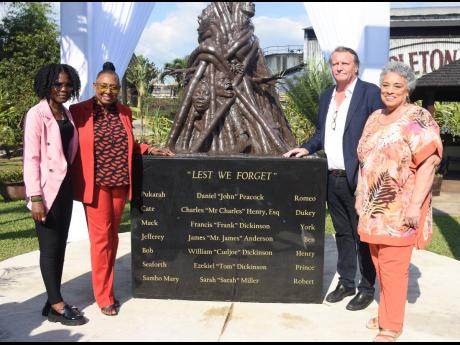‘I was afraid at one point’
Artist admits undergoing therapeutic transformation while carving slavery monument
WESTERN BUREAU: Visual artist Trishaunna Henry went through a spiritual journey while creating the slave monument unveiled by J. Wray...
WESTERN BUREAU:
Visual artist Trishaunna Henry went through a spiritual journey while creating the slave monument unveiled by J. Wray & Nephew on Monday at the Appleton Estate in St Elizabeth.
Appleton is the first former slave plantation to honour the men and women whose blood, sweat and tears were shed while making sugar cane the king in not only Jamaica, but the rest of the world. The monument has been tagged ‘Lest We Forget’.
“I wanted the feel of my ancestors telling me a story or sharing their issues, or if I could go back in time, and just capture the pain and the anguish, the struggle that they went through, I wanted it to be this monument,” the 26-year-old Glenmuir High School teacher told The Gleaner on Sunday, hours before the unveiling the 12-foot structure.
She didn’t want history to be whitewashed.
“I wanted the feeling and truth with this space. That whole thought process. It was a lot I had to go through while making the piece spiritually, like investing in this piece, and the healing that I had to do,” Henry explained. “I didn’t know until I was doing this piece that I had memories and baggage from my ancestors that came down in our DNA and through our upbringing.”
Henry revealed that during the six months that it took her to complete the piece, including four nights of no sleep, she had to heal from most of the trauma through the artwork.
The young visual arts teacher, who wears her hair naturally and admits that she would not relax her coils as she never wanted to look European, argued that black Jamaicans are living with unhealed trauma.
“We got our freedom and like any traumatic event that any race goes through, normally they say, ‘Get some therapy’, but there was no therapy after slavery,” she argued.
Henry told The Gleaner that while creating the monument, she realised she was not just doing a piece for her ancestors, but for herself and every Jamaican descendant of enslaved people.
At the unveiling on Monday, when she addressed an audience – which included Culture Minister Olivia Grange; Professor Verene Shepherd, director of the Centre for Reparation Research; Jean-Phillippe Beyer, managing director of J. Wray & Nephew Limited – Henry said that while working on the monument, it was like all of the ancestors found St Catherine, “down a mi yard”.
As heartily as the audience laughed when she made that revelation, Henry’s next admission brought tears to the eyes of many.
“I went through a journey that I cannot articulate to you guys today. I went back in time with this piece. I had to pause. I was afraid of the monument at one point. I saw my ancestors,” she said, revealing that when she started sculpting the faces, she plummeted to an all-time low.
“All of this trauma is passed down in our DNA. And it’s in our language, some of you don’t even like to hear Patois because it makes you feel uncomfortable, but we have to fix it,” said the artist.
Today, she is convinced that it was no coincidence that she was selected for the job.
Henry, who won a publicly advertised competition sponsored by J. Wray & Nephew, said she was intentional when she made her pitch.
“I made sure that you guys knew I was not coming to water down or pretty up any monument so you guys can feel good or digest it easily. I want when we walk away from this monument today, some of us will want to do some research and start to heal,” she said.
It was a strenuous six months working on the piece, balancing it with her duties as a teacher. So she had to work on the monument at nights.
“That, in itself, made everything feel longer because I didn’t have the full time in the initial stage work on it,” she reminisced.
However, she would get extra muscles from some team members every now and again.
Some of the times, Henry would work on the piece until her body said no more.
“I spent my entire Christmas and my birthday on the monument,” she revealed, and when it got closer to the deadline, sometimes for days she would go without sleep to complete the monument.


